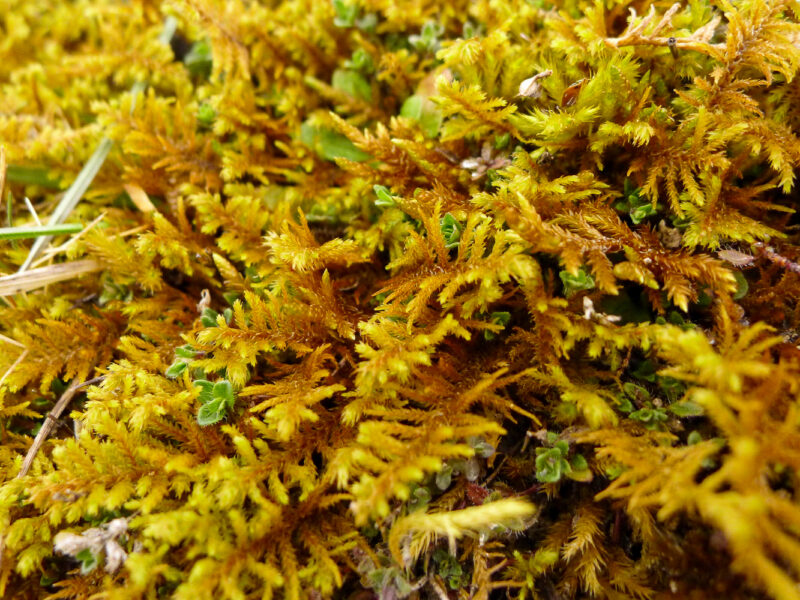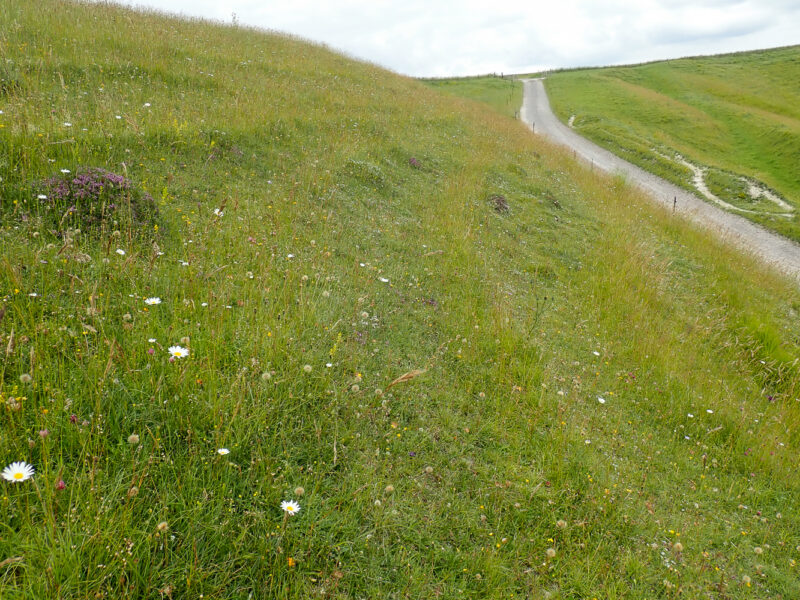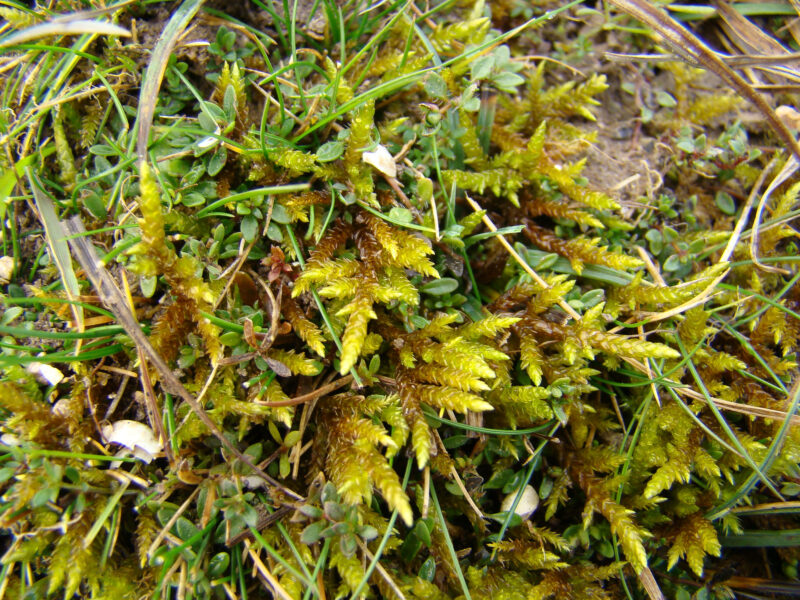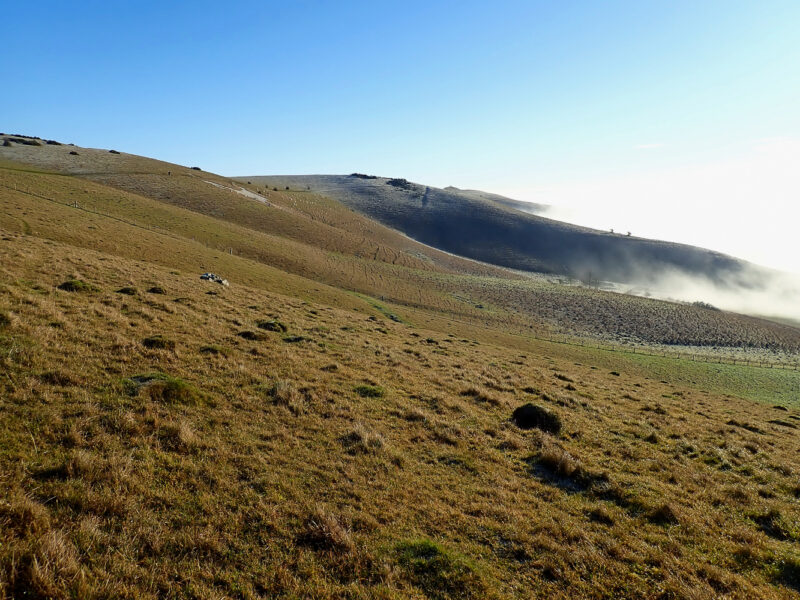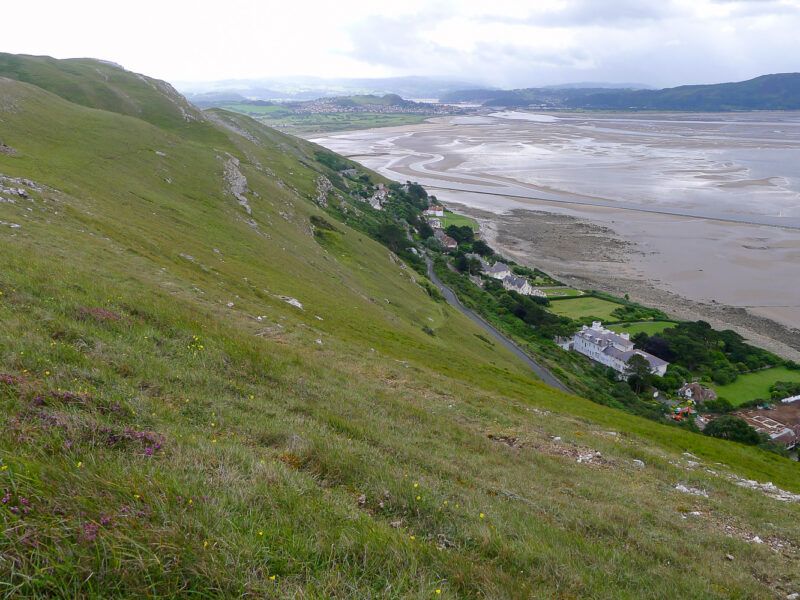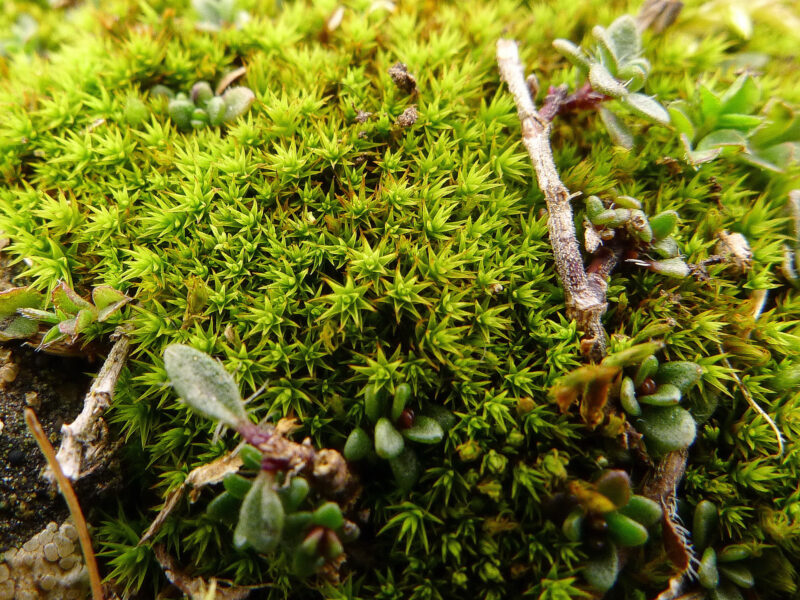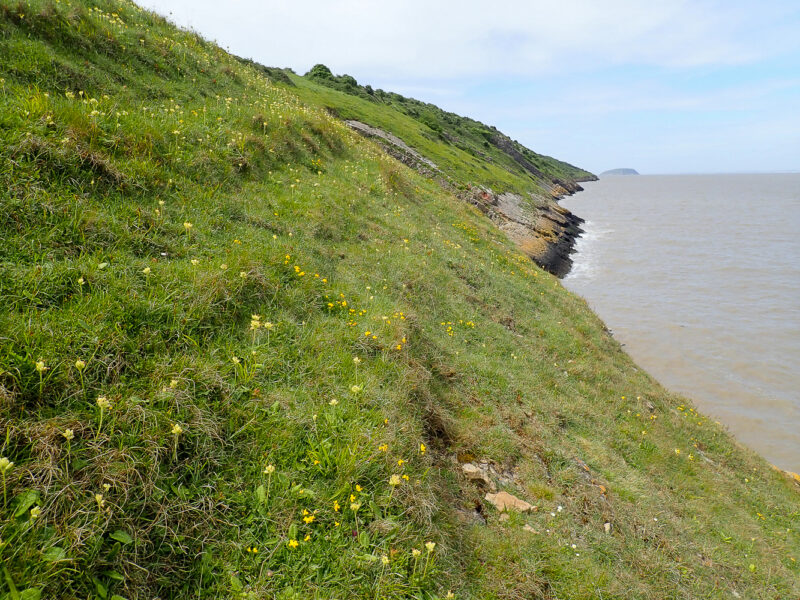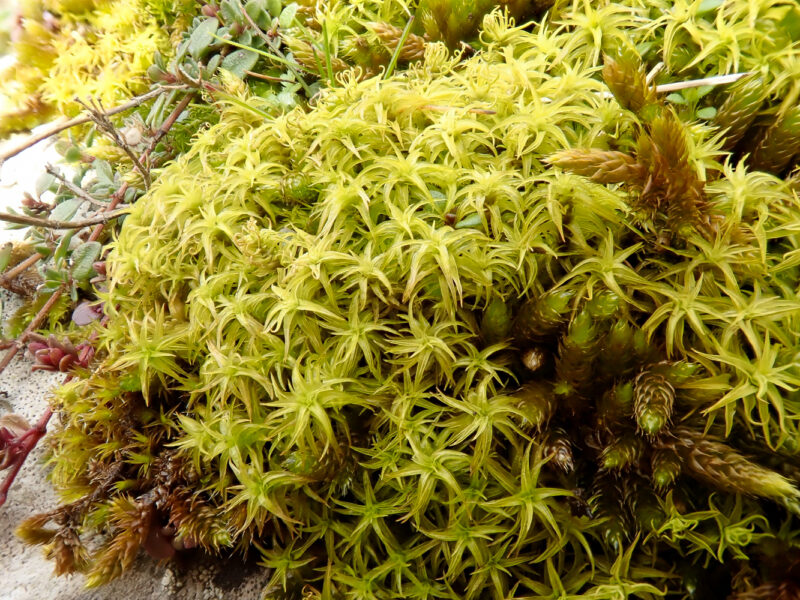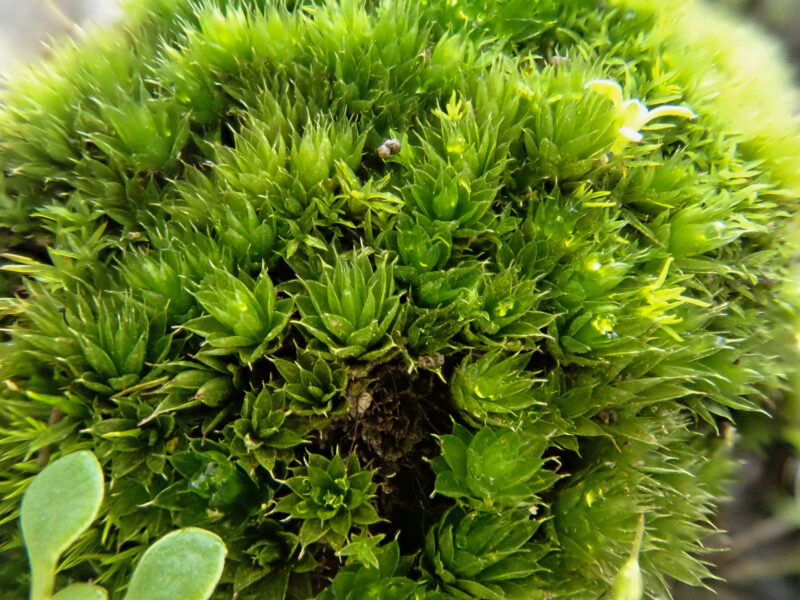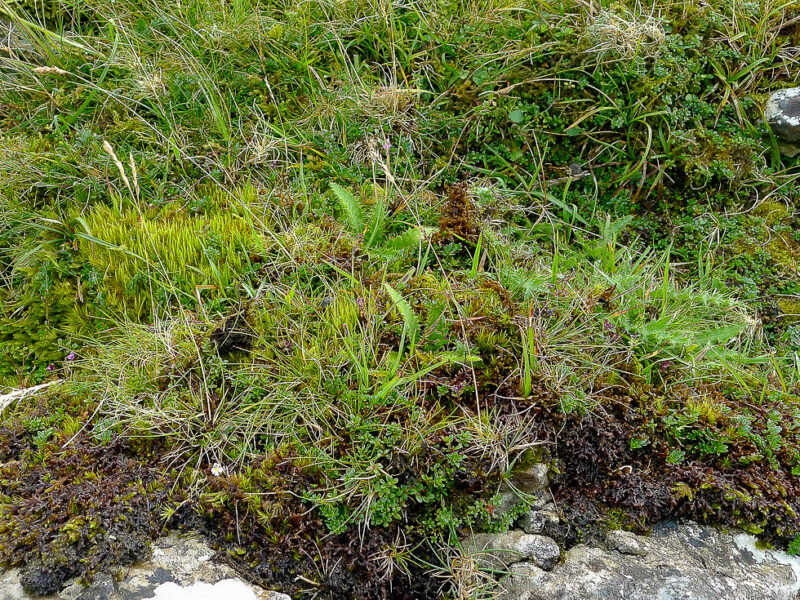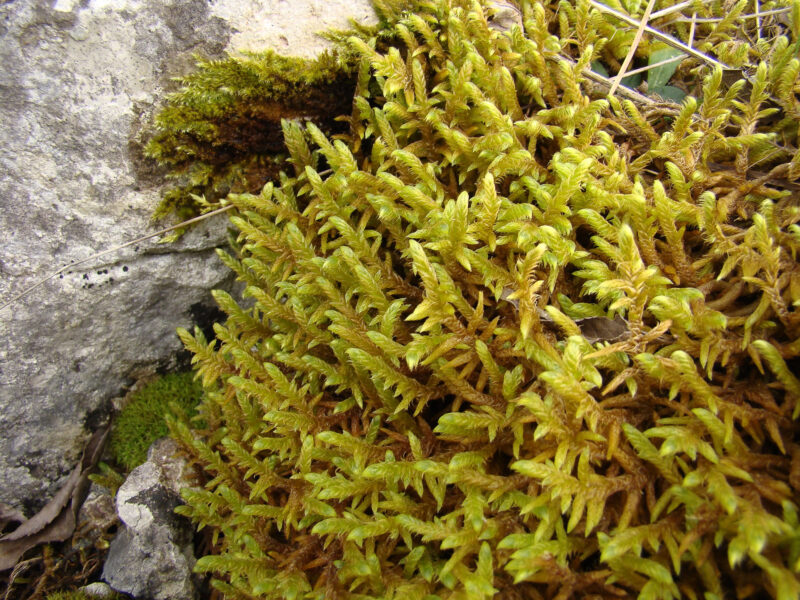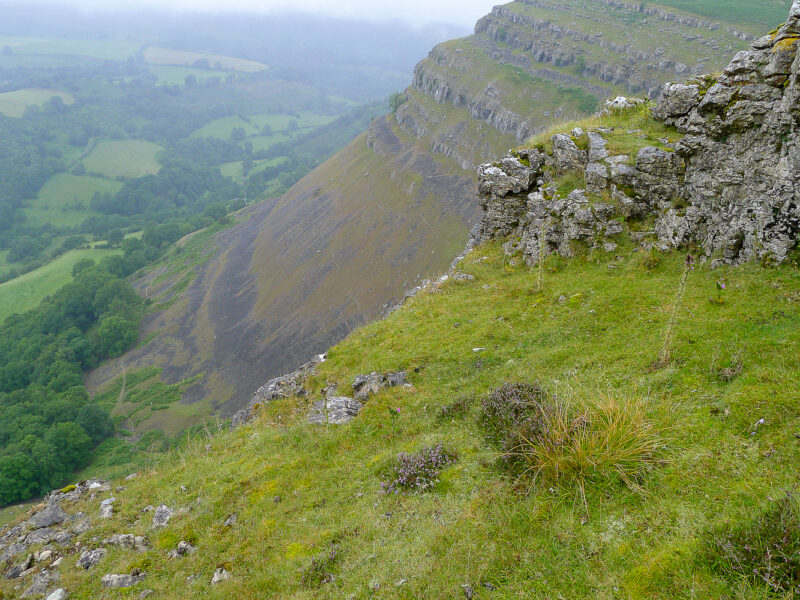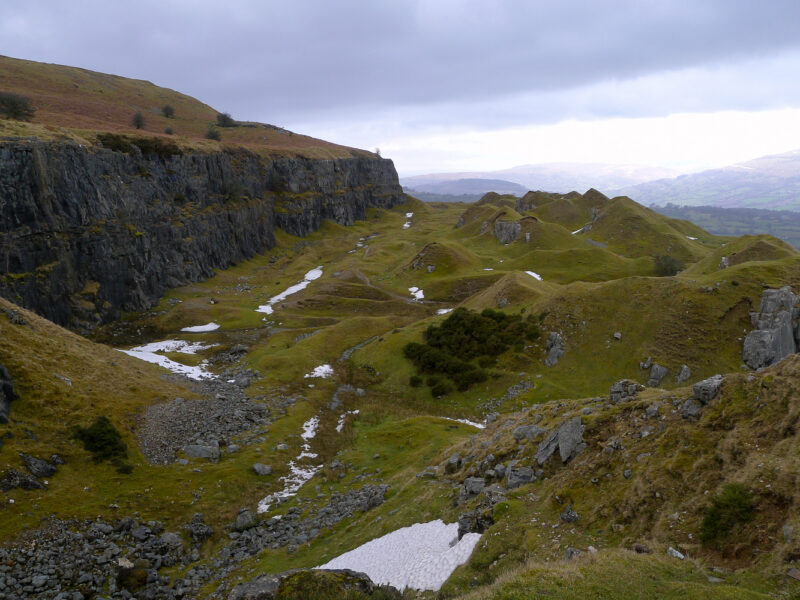Introduction to calcareous grassland
Calcareous grassland is grassland growing on thin, freely draining or skeletal soils where the underlying bedrock is limestone or another strongly basic substrate – examples include hard Carboniferous limestone, chalk, soft oolitic limestone (often known as Bath, or Cotswold stone) and cornbrash. This grassland can occur in extensive tracts or fragments.
The richest examples of calcareous grassland are typically ancient swards that have been grazed by sheep or other herbivores for centuries, developing into a tight, species-rich sward with a high diversity of species to develop. Calcareous grassland supports many rare and declining higher plant species as well as a distinctive assemblage of bryophytes too. The species likely to be found in any particular area are influenced strongly by biogeographic situation, aspect, altitude and habitat management.
Lowland calcareous grassland
Lowland calcareous grassland is a rare and declining plant community of very high conservation importance and consequently is often found in statutory sites of high conservation importance (SSSI, ASSI) or in county wildlife sites or other local equivalents. Lowland calcareous grassland varies in floristic composition and corresponds to National Vegetation Classification communities CG1 to CG8.
Common bryophytes
Depending on management and aspect, certain species are very characteristic of chalk downland or other lowland calcareous grassland. These include large common pleurocarpous mosses such as Homalothecium lutescens, Pseudoscleropodium purum, Calliergonella cuspidata, Hypnum cupressiforme var. lacunosum and Ctenidium molluscum. Brachythecium glareosum, Campylium chrysophyllus and Flexitrichum gracile can be frequent in some sites.
Oxyrrhynchium hians and Brachythecium rutabulum can be unexpectedly common too, especially in neglected or reversion swards. Where thatch accumulates between tillers, the calcifugous Rhytidiadelphus squarrosus and Lophocolea bidentata can thrive. Small bryophytes may be confined to sheepwalk or other broken turf, but such areas may support populations of Aloina aloides, Fissidens taxifolius or F. dubius, Trichostomum crispulum, Barbula unguiculata, Didymodon fallax, D. rigidulus, D. vinealis (southern sites) Weissia controversa, W. brachycarpa var. obliqua, Dicranella varia and D. howei. Microbryum species are also common in some grasslands, with M. davallianum, M. rectum and M. curvicollum all conspicuous in the winter months when their capsules are present.
Cool and humid slopes with a sheltered and/or north-facing aspect can be good places to find large pleurocarps, including Neckera crispa and Hylocomiadelphus triquetrus. Sometimes Hylocomium splendens, which in the lowlands is rarely found away from acid soils, will be present in such places. Most lowland calcareous grassland is too dry (in summer at least) to support many hepatics, although broken ground and sheltered tracks on north-facing slopes may have Mesoptychia turbinata or more rarely, M. badensis, Pellia endiviifolia and Riccardia chamedryfolia.
Uncommon species
This is a long list! You’ll know that you are in the best lowland calcareous grassland when you find Entodon concinnus, which, though widespread, is sometimes restricted to one place in any particular site. It’s a species that is quite often associated with very tightly grazed turf on south to west-facing ancient earthworks.
The very beautiful, though scarce, Abietinella abietina likes similar places. Other rarities include Weissia sterilis, a difficult species to recognise when it lives up to its name, Aloina rigida, A. brevirostris, Pottiopsis caespitosa, Bryum torquescens, Pterygoneurum ovatum, and rarely P. papillosum. Gymnostomum viridulum is very small and normally must be searched for – it likes barely vegetated soil pockets on slopes with a warm, sheltered aspect. Microbryum floerkeanum and Ephemerum recurvifolium are diminutive species that are easily overlooked and best hunted down in the autumn.
If you are really fortunate, you may come across the very rare and very small Oleolophozia perssonii on sheltered, eroded chalk – instantly recognisable by its brown leaf gemmae, it is very easily overlooked. Didymodon acutus used to be regarded as a classic indicator of unimproved calcareous grassland but recircumscription of the species has shown that plants inland are almost always D. icmadophilus, which can also be found on forestry tracks and disused quarry floors.
Important microhabitats
In any given tract of calcareous grassland, it is not usually the closed sward that supports the notable species. The discerning bryologist will search out sheltered niches and especially those where there has been some disturbance, or broken ground, as these often support small ephemerals. Rich pickings may be had in various bryophyte microhabitats:
- Ancient earthworks, such as banks, holloways, hill fort ramparts and tumuli. Scapania aspera, Weissia sterilis, W. angustifolia and Entodon concinnus may be found in sheltered turf here and, where hard chalk pebbles or limestone stones are embedded in the turf, look for species of Seligeria and – much more locally, Tortella inflexa.
- Soil ledges over rock exposures – home to Entosthodon muhlenbergii, E. pulchellus, E. mouretii, Bryoerythrophyllum ferruginascens, Riccia sorocarpa, subbifurca, Reboulia hemisphaerica, Tortula lindbergii, Bryum kunzei and Pleuridium subulatum. Some sites even have Targionia hypophylla;
- Ant-hills – These offer more neutral to acid soils and often have many pioneering species such as Ephemerum species, Acaulon muticum, Bryum species and Tortula truncata. Rhodobryum roseum is a classic anthill species but it is frequently absent or rare in many sites where there are numerous ant-hills;
- Sheepwalk and paths;
- Disused quarries and pits
Optimal survey season
Although many species of limestone grassland can be identified year-round, surveying between February and April is most likely to record the greatest number of species, as this is when many of the smallest or ephemeral mosses have mature capsules and so can be readily identified.
Coastal calcareous grassland
The temperate climate and sea fog of coastal calcareous grassland affords special conditions that are reflected by the presence of a particular suite of bryophytes and this vegetation type, although rare, can be an exciting place to survey. The most summer-droughted grazed forms typically correspond to the NVC’s CG1 community, which is partly defined by the presence of certain rare plants. Others, especially in the north, may correspond to CG2, CG3 or other lowland communities.
Good examples of coastal calcareous grassland which support rich bryophyte communities include Berry Head in Devon, Sand Point and Brean Down in Somerset, Southgate Cliffs (Gower Peninsula) and the Great Orme, near Llandudno.
The most conspicuous bryophytes are often the same ones found elsewhere in lowland calcareous grassland, with additional species such as Rhynchostegium megapolitanum, Tortella flavovirens, Trichostomum brachydontium agg. and Scleropodium touretii can be frequent in the turf. The scarce Tortella squarrosa is often quite common in such grassland, although it is not restricted to coastal habitat.
There is a long list of coastal rarities, but they are often very localised and site-specific. Weissia perssonii is quite widely distributed, but W. condensa less so. Cheilothela chloropus is restricted to Carboniferous Limestone in Devon and Somerset and Acaulon triquetrum to the south coast. Other southern rarities include Cephaloziella baumgartneri and Southbya tophacea, Weissia levieri and Didymodon acutus s.str.
Limestone exposures in coastal grassland can be excellent places to look for Scorpiurium circinatum and Grimmia orbicularis. Thin pockets of soil around such exposures may support Encalypta vulgaris, G. viridulum, E. muhlenbergii and E. pulchellus. On thin soil ledges over such outcrops, Bryum canariense can sometimes be found, its handsome dark red-green patches occasionally bearing capsules.
The Southern Hepatic Mat/Scapanietum asperae association
The Southern Hepatic Mat or Scapanietum asperae is a special association of large leafy liverworts that grows alongside mosses and vascular plants in rich calcareous grassland. It is considered to be a rare vegetation type both nationally and globally and usually occurs in small fragments.
The Scapanietum asperae is described as a ‘distinctive association of leafy liverworts and mosses of north-facing, grazed chalk grassland.’ It is characterised by the presence of one or more of the liverworts Frullania tamarisci, Porella arboris-vitae and Scapania aspera in a turf dominated by bryophytes. At least six other characteristic bryophytes, particularly H. cupressiforme var. lacunosum, N. crispa, C. molluscum, D. scoparium and P. purum should also be present to qualify.
The association is quite widely distributed but has declined considerably on the chalk in southern Britain, where it was first described. Recent work has shown that grassland over Carboniferous Limestone in Wales is a stronghold for the community (Pilkington, 2019). It has recently been found at a number of sites along the north Wales coast and at inland localities in Denbighshire. Small fragments of the Scapanietum asperae also occur in limestone grassland in Somerset’s Mendip Hills and elsewhere.
Usually, the association is found in thin, well-grazed species-rich calcareous grassland associated with rock outcrops in north-facing situations, which provide it with year-round cool and damp conditions preferred by its three signature leafy liverworts. At some coastal localities, such as on the Great Orme, it can also tolerate a wider range of aspects and occasionally the community will develop on north-facing quarry spoil heaps.
Upland calcareous grassland
Upland calcareous grasslands are found above the upper limit of agricultural enclosure (which is usually at 250-300m altitude), both in the sub-montane and montane zones. Unlike their lowland counterparts, they typically occur as components of habitat mosaics, which are generally managed as rough grazing land for domestic livestock. This kind of grassland is a relatively rare upland vegetation types which supports a wide range of uncommon vascular plants and bryophyte.
This kind of grassland is generally restricted to shallow soils derived from a variety of lime-rich bedrocks including limestone, some shales and sandstones and even dolerite, basalt and other basic igneous rocks. In Scotland, calcareous grassland is also found over metamorphic bedrock, such as the calcium-rich schists of the Highlands.
Most examples of upland calcareous grassland can be assigned to NVC communities CG9-CG14 plus CG1 and CG2 occurring above the limit of agricultural enclosure.
Bryophytes are often equally if not even more prominent than in lowland counterparts. Ctenidium molluscum, Tortella tortuosa, H. cupressiforme var. lacunosum, F. gracile, F. flexicaule, D. scoparium, P. purum, F. dubius, Encalypta streptocarpa, R. squarrosus and N. crispa can all be conspicuous.
Upland calcareous grassland is often very rocky and the exposures of bedrock with associated crevices and bare soil provide habitat for small species. However, the communities of small Pottiaceous species that characterise many lowland calcareous grasslands are usually much reduced here.
Such grassland, occurring as it does at higher altitude and in areas of high precipitation, is sometimes leached and this encourages populations of certain vascular plants and bryophyte that are normally regarded as calcifuges. Rhytidiadelphus loreus, Hylocomiadelphus triquetrus, H. splendens and Pleurozium schreberi can be found side by side with calcicolous bryophytes. Calluna vulgaris, Vaccinium myrtillus and various lichens may also be present. Sub-montane communities are likely to have Racomitrium lanuginosum, R. canescens, Breutelia chrysocoma and Polytrichum juniperinum. Rare species may include Bryum elegans, Rhytidium rugosum and Tortella densa.
Hepatics can be quite frequent in upland calcareous grassland, especially in cool, sheltered places that stay humid year-round. Common hepatics may include Plagiochila asplenioides, P. porelloides var. porelloides, Barbilophozia barbata, Scapania aspera, S. aequiloba, Ptilidium ciliare, Frullania tamarisci and Tritomaria quinquedentata.
Montane grasslands at the highest altitudes may also have much Pogonatum urnigerum, Polytrichastrum alpinum as well as numerous mosses and hepatics of restricted distribution.
Management, conservation and threats to bryophytes of calcareous grassland
In general, the management approaches that benefit the higher plant communities of calcareous grassland are also good for its populations of mosses and liverwort and the best sites are usually sustained through a combination of good grazing and localised disturbance. Like certain vascular plants, bryophytes will often seek out places where shelter is afforded by topography e.g., on sloping ground or near rocks and scrub, so structural diversity can also be very important.
On some sites, illegal disturbance from e.g., off-road motorcycles may look unattractive but may actually be beneficial to small bryophytes of calcareous grassland that are poorly competitive and need exposed ground to complete their life-cycles.
However, bryophyte populations in calcareous grassland still face myriad threats from:
- Habitat neglect: inadequately grazed grassland coarsens, and scrub invades, eliminating the short turf and soil gaps that are so important to many species;
- Overgrazing: this is mainly a problem of upland calcareous grazing in Wales, Scotland and Ireland. Unsustainable stocking densities of sheep or deer cause erosion and loss of species except on remote ledges and cliffs, which are inaccessible to the livestock. In some other sites, such as Cheddar Gorge, well-meaning introduction of goats to manage calcareous grassland on very steep slopes leads to serious erosion and over-grazing when animals are allowed to multiply unchecked;
- Invasive non-native plants: in many lowland/coastal calcareous grasslands bird-sown Cotoneaster horizontalis and microphylla smother open ground and eliminate native plants and bryophytes;
- Tor-grass: Although native, Brachypodium rupestre has aggressively spread across many lowland sites, especially where there have been grass fires and insufficient grazing. A dense rhizomatous sward of this grass leaves little room for anything else;
- Eutrophication: Regular dog-walking can cause localised soil enrichment from urine and faeces. This can be a significant problem in calcareous grassland sites close to towns and villages where there are public rights of way or informal site access. Other calcareous grasslands lie downwind of busy roads, intensively managed farmland and dairy or poultry units and in consequence suffer nitrogen enrichment. Most bryophytes of calcareous grassland are specialists of poor, infertile soils;
- Heavy human footfall: a particular concern during the covid pandemic and on coastal sites near popular holiday resorts, causing compaction of the ground and erosion. Whilst a few species are tolerant of some degree of trampling, too much can reduce or eliminate populations;
- Fire: the current popularity of barbeques in the countryside is responsible for many fires and can eliminate populations of bryophytes that are found around rocky knolls where BBQs are lit;
- Climate change: Changing weather patterns are likely to affect the populations of bryophytes of calcareous grassland, although it is still too early to say how. Hot and dry summers in particular will certainly increase the risk of damaging fires in grassland sites.

